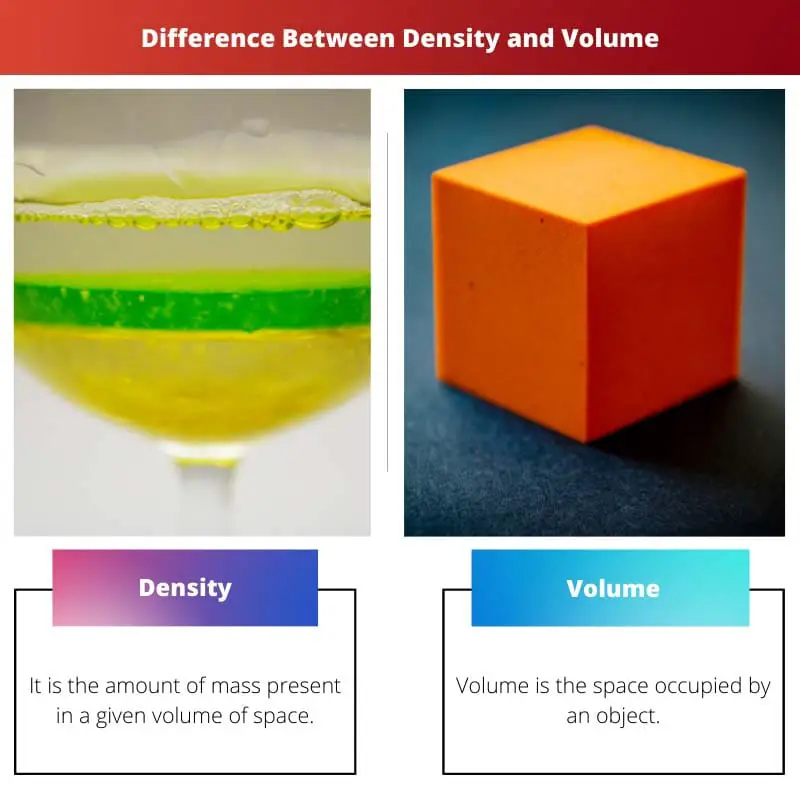Mensuration is an integral process in the day-to-day activities in most practical and corporate, and academic fields. Density and volume are both important terms.
Both are quantifiable quantities that describe the physical properties of an object. However, the object must be measured for both properties to have mass.
Mass is essential for calculating various physical quantities, not just density and volume.
Key Takeaways
- Density measures the amount of mass per unit of volume; volume is the amount of space an object occupies.
- Density is a material property and can vary based on temperature, pressure, and other factors; volume is an intrinsic property of an object.
- Density is measured in kilograms per cubic meter (kg/m3); volume is measured in cubic meters (m3) or in units derived from cubic meters, such as litres (L).
Density vs. Volume
The difference between density and volume is that density tells how closely the molecules are packed in an object. In contrast, volume tells us about the physical space occupied by an object.

Density is defined as the amount of mass that is present in an object for a given volume. Density is used to establish and understand the relationship between mass and volume.
Physically, it tells us how closely the molecules of the substance are packed together. A high density means that the molecules are packed closely.
On the other hand, volume is defined as the amount of physical space an object occupies. Volume comes in handy for practical use in planning activities when we use it to determine how much space something will occupy.
Volume is an essential measure for liquids since they do not have a definite shape and hence can not be measured in terms of area.
Comparison Table
| Parameters of Comparison | Density | Volume |
|---|---|---|
| Definition | It is the amount of mass present in a given volume of space. | Volume is the space occupied by an object. |
| Nature | Intensive in nature. | Extensive in nature. |
| SI unit | Kilograms per cubic meter (kg/m3) | Cubic meter (m3) |
| Formula | mass/volume | length3 |
| Relation with Temperature | Decreases with an increase in temperature. | Increases with an increase in temperature. |
What is Density?
Density is a measure of mass per unit volume. This is the most standard definition of density and is, in fact, the simplest too.
In everyday life, when we talk about how dense an object is or how dense a liquid is, we mean to say that the individual molecules are packed very closely in the liquid.
And when the molecules are packed closely, more molecules can fit in a given amount of space.
When more molecules can fit in the given amount of space, it automatically results in more mass being occupied.
We measure space in terms of volume, as it is a three-dimensional quantity, so more mass in a given amount of space results in more mass in a given amount of volume.
To standardize this measurement, we consider the mass present in a unit quantity of volume, which leads us to derive the formula for Density. The formula for density is
D = m/V
Where,
- D = Density
- M = Mass
- V = Volume
Density decreases as temperature increases. This can be understood as when the temperature increases, the energy in the molecules of the substance increase and hence tend to drift away from each other, and thus, it increases the volume of the substance.
Since density is inversely proportional to volume, as volume increases, density decreases. This decrease is highest in gases, followed by liquids and then solids.
Density is an important day-to-day physical quantity, which comes into use in several ways. The most well-known use of density is determining whether an object will float in water.
This is more prevalent in the shipping industry, as they need to keep the shipment density lower than the density of water.
Another use is making consumer products like condensed milk, where the density of the product matters. Having a general idea of density helps in similar day-to-day cases.

What is Volume?
Volume is the physical three-dimensional space that is occupied by an object. When dealing with the volume of stuff that needs to act as containers, we use the term capacity instead.
Volume is an important quantity and is very frequently used daily.
We use volume when we need to buy a bottle of water; we use volume when we need to buy a refrigerator. We keep the volume of the boot space of a car in mind when we purchase a car.
Volume is crucial in some cases, like the making and designing of an airplane or a ship.
The formula for volume is as follows:
V = L3
Where,
- V = Volume
- L = Length
Length is a basic fundamental quantity, and since we take the cube of mass to calculate volume, volume is a three-dimensional quantity.
For simple objects whose sides are easy to calculate, such as a cube or a cuboid, in those cases, the calculation of volume is really simple.
- In the case of a cube, the formula for volume is (length of a side)3.
- In the case of a cuboid, the formula for volume is (length X breadth X height)
In either case, the dimension results to be L3.

Main Differences Between Density and Volume
- The main difference between density and volume is that density tells us how much mass is present in a given amount of space, and volume tells us about the space occupied by an object.
- Density is intensive, meaning it is an internal property of the substance. Volume is extensive.
- SI unit of density is Kilograms per cubic meter (kg/m3), while the SI unit of volume is per cubic meter (m3).
- The formula for density is (mass/volume). The formula for volume is (length)3.
- Density decreases with an increase in temperature, while volume increases with an increase in temperature.

- https://acsess.onlinelibrary.wiley.com/doi/abs/10.2136/sssabookser5.1.2ed.c13
- https://www.spiedigitallibrary.org/conference-proceedings-of-spie/2359/0000/Volume-visualization/10.1117/12.185241.short?SSO=1

The post provides a clear distinction between density and volume. Such graphical representation is optimal for learning these concepts with ease.
I couldn’t agree more. The visual representation adds significant value to the post, making it a remarkable educational resource.
The use of a comparison table is indeed effective in understanding the differences between density and volume. It’s a great addition to the article.
This article provides an exceptional breakdown of the key takeaways concerning density and volume. A truly illuminating read for anyone interested in these topics.
I totally agree. The detailed information elucidates these complex concepts, making them accessible to a wide range of audiences.
Absolutely. The explanations are crystal clear and highly beneficial for academic, professional, and practical purposes.
This article is undeniably an invaluable resource. The comprehensive explanation, including the comparison table, is exceptionally beneficial.
Indeed. The value addition through the comparison table is remarkable and serves to elucidate the distinctions between density and volume perfectly.
Absolutely. The detailed breakdown is not only informative but also immensely enlightening. Kudos to the author for such a noteworthy piece.
The article serves as a rich and insightful resource. The detailed explanations of density and volume are truly commendable.
Absolutely. The exceptional breakdown of density and volume is fantastically informative and enlightening. A must-read for anyone looking to comprehend these concepts more deeply.
Absolutely agree. The depth of insight and clarity of explanation make this article a truly invaluable guide for anyone interested in these subjects.
The way this article breaks down the differences between density and volume is truly praiseworthy. A commendable piece!
Absolutely. This post is a valuable educational tool, offering an adept and scholarly analysis of density and volume.
Agreed. The depth of insight into these topics is impressive and enriching. The readers’ comprehension is undoubtedly enhanced.
Kudos to the author for presenting such an elaborate and comprehensible explanation of density and volume. Truly an outstanding piece.
Absolutely. This post is a reflection of thorough research and insightful interpretation, providing a truly educational and enlightening exploration of density and volume.
This post meticulously explains density and volume, providing a comprehensive understanding of these pivotal physical properties.
Indeed. The detailed elaboration of density and volume is truly excellent, enabling readers to delve deep into these topics.
This article is a great resource for students and professionals alike. The thorough comparison table definitely adds value to this post.
Great overview of density and volume. It’s clear and concise information on two essential physical properties. Perfectly explains such intricate concepts in physics and chemistry.
It’s enlightening to read such a comprehensive breakdown of two incredibly important physical measures. Dense and voluminous with useful information, just like the subject matter.
I agree with you. This post simplifies the understanding of density and volume for everyone. I appreciate the straightforwardness of the explanation.
I appreciate the increase in understanding of the subject matter thanks to this informative piece.
Absolutely. The detailed explanation of density and volume makes it easier to grasp these concepts and apply them in analytical work.